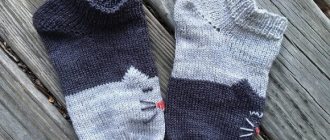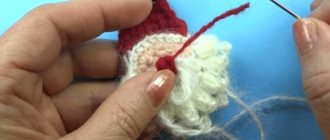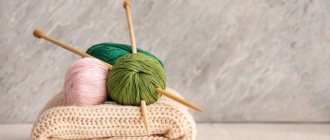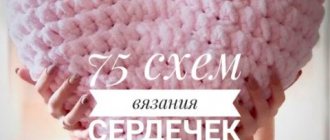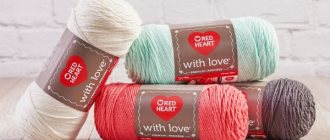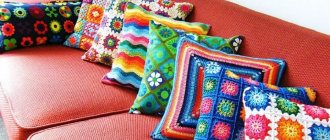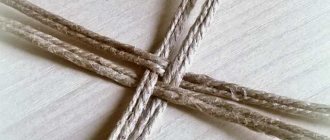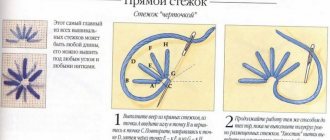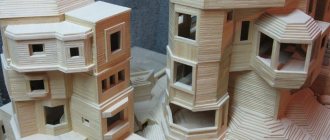Mittens for a baby are knitted in exactly the same way as for an adult, only the number of stitches will be fewer. For a 1.5 year old child, I cast on 26 stitches. I used regular double needles. The size of the knitting needles is 2 (it doesn’t seem to be thinner, although I could be wrong). Knitted in two threads.
In general, the number of loops is a relative unit. After all, each craftswoman knits with a different density, the size of the knitting needles and the thickness of the thread may vary. If you have thicker knitting needles, it is better to reduce the number of loops. As a last resort, you can knit a couple of rows and try it on a child’s hand. If it is too much or too little, it is better to immediately dissolve and re-assemble.
Beige goat down and blue acrylic
For the work I used two types of threads: blue acrylic and beige goat down. I also needed double needles. Since there were few loops, 4 knitting needles were enough. Also prepare a pin; you will need it for the thumb on the mitten.
Yarn selection
The choice of yarn is primarily based on color, texture and price. But this is not enough. The label of the skein should contain information that is useful to read.
To select yarn, you should pay attention to the following parameters:
- skein weight;
- length in skein;
- thickness;
- compound;
- color uniformity/dye fastness;
- stretch/shrinkage ratio;
- tensile strength.
Important! When choosing yarn, you need to be guided not only by the weight of the skein, but also by the length of the thread, since with the same weight, yarn of different textures can have completely different lengths.
Types of yarn
Knitting yarn can vary in composition, texture, thickness, twist and color. These factors determine the purpose of hand knitting yarn.
The yarn is like this:
| Origin | Kinds | |
| Natural raw materials | Plant origin | Animal genesis |
| Viscose, cotton, linen | Cashmere, wool, silk, mohair | |
| Synthetics | Acrylic, polyester | |
| Mixed fibers | Various combinations | |
In addition, the yarn can be:
- twisted with several threads;
- homemade, self-spun;
- large and small boucle;
- polished.
Yarn for knitting needles and crochet
You can knit any yarn on knitting needles. But when choosing, special attention should be paid to the uniform thickness of the thread in the skein along the entire length. If there are thickenings or areas of thinning of the thread, then such yarn is not recommended for openwork and stocking stitches. Uneven yarn is used for knitting raised patterns or in combination with yarn that matches the color.
For crochet needlework, the choice of yarn and special threads is much wider. Any yarn is suitable for this knitting, as well as “iris”, “floss”, “krashe”, “garus” and thick bobbin threads.
Yarn for mittens
Mittens should be warm, soft, and not easily ventilated. Based on this, the spinning threads are selected mainly natural - wool, wool blend, mohair, angora. For mittens it is possible to use mixed yarn. For example, wool - acrylic, or mohair - cotton.
Self-spinning from goat fluff remains popular to this day - the same yarn that grandmothers and great-grandmothers used. From self-spun fiber, needlewomen like to use goat, camel and dog hair.
Among modern yarns for knitting mittens, we can recommend Kaun wool, YarnArt Jeans, Trinity “New Zealand” wool, and Laika.
Now we are on Yandex.Zen.
You might be interested in:
How to knit mittens with knitting needles, mittens.
Children's mittens knitted. Schemes, description, photos. Several variants.
How to knit men's mittens with knitting needles.
Mittens knitted from mink fluff.
Women's leg warmers, crocheted
Set of knitting needles with deer: hat, scarf, mittens. Knitting patterns, description.
Women's mittens with knitting patterns
Knitting mitts with a description, a finger knitting pattern with an “Indian wedge”, and a false braid pattern.
Snood knitted and crocheted. Nine options.
Gloves with knitting needles with and without an openwork pattern. Schemes, description.
Knitting needle selection
The quality of the knitted fabric, its smoothness and uniformity depend on the type of knitting needles. The choice of knitting needles depends on the type and thickness of the yarn, so this issue must be approached responsibly.
Correct choice of knitting needles:
- the desired design (knitting needles with stops, Teflon or metal on fishing line, stocking or hooks);
- the required thickness and length (depending on the yarn, knitting density);
- from the preferred material (wood, bamboo, plastic, metal);
- of adequate quality (smooth, without jagged edges, with a comfortable end and stopper).
Approximate correspondence between knitting needle size and yarn thickness:
| Yarn thickness (thread length per 100 g weight) | Recommended spoke thickness |
| 50 m – 100 g | 7 – 15 mm |
| 100 m – 100 g | 6 – 9 mm |
| 150 m – 100 g | 5 – 7 mm |
| 200 m – 100 g | 4 – 6 mm |
| 300 m – 100 g | 3 – 4.5 mm |
| 400 m – 100 g | 2 – 3.5 mm |
| 800 m – 100 g | 1.5 – 3 mm |
The label of a standard skein of yarn usually indicates the recommended number of knitting needles.
However, everyone’s knitting style is different - some prefer tight knitting, while others prefer loose knitting. Beginner knitters, for the most part, knit very tightly, so larger knitting needles are recommended for them. Conversely, for weak and loose knitting, thinner knitting needles are needed. For knitting mittens, gloves, and mitts, stocking needles are most suitable. These are 5 shortened knitting needles without a ring or stopper. They are convenient for knitting even small fingers on mittens and gloves in a circle and learning how to knit.
To knit mittens from yarn with hard fibers, use smooth metal knitting needles, and for polished yarn, use plastic or wooden knitting needles.
Cartoon knitted mittens for a 7 year old girl
Funny and cool mittens for a 7-year-old girl on the theme of cartoon characters can be knitted. Funny Angry Birds will be able to live on warm winter mittens.
We will need:
- Yarn 200 g (two colors)
- Stocking needles 5 pieces.
Knit a sample from your yarn and take measurements of the hand of a 7-year-old girl for knitting mittens.
It is necessary to divide all the loops into 4 knitting needles and connect them in the round.
We knit 5 cm with an elastic band of 1*1 cm (knit 1, purl 1)
We will need the first two knitting needles for knitting the front part of the mittens, and the other two for the bottom.
We knit 5 cm in garter stitch up and add 2 loops per row.
Tie to the point where your thumb starts. On the third knitting needle we need to make a hole for the finger. If we knit the left mitten, then use the 4th knitting needle.
We transfer the loops for knitting the thumb to an additional knitting needle and continue knitting the main fabric of the mitten. Having knitted the desired length, change the color of the yarn.
After tying your thumb, close the loops. We will knit the parts of the bird's face using a hook and sew them to the mittens. The eyes may be made of beads.
Selection of schemes
Mittens with knitting needles (patterns and descriptions are presented below) can be knitted in several ways, it all depends on personal preferences and what you want to get in the end.
You can knit mittens this way:
- On 2 knitting needles with a seam, a single fabric (thumb in front).
- On 2 knitting needles with a seam (thumb on the side).
- On 2 knitting needles with a seam (with a wedge for the thumb).
- On 4 needles without seam (thumb in front).
- On 4 knitting needles without a seam (with a wedge for the thumb).
- Crochet around the circumference of the palm or along it (the thumb is similar to the base).
- On circular knitting needles, without seam or with seam (any thumb knitting method).
In addition, mittens can be made with a beautiful combined pattern, with “braids” and “flagella”, with openwork knitting, “boucle”, with jacquard patterns...
Knitting pattern for mittens on 2 knitting needles with a seam and a thumb on the side
This method of knitting mittens is used quite rarely. It is simple and does not require special knitting skills.
The main thing is to observe the correctness of the sequential execution according to the scheme. This knitting method is used when the pattern of the mitten needs to be placed across the product.
Knitting pattern for mittens on 2 knitting needles with a wedge for the thumb
These mittens are knitted traditionally, starting with an elastic band. The thumb is tied with a wedge. Mittens according to this pattern are very comfortable due to the natural, physiological position of the finger.
How to knit a finger with a wedge on mittens. Detailed diagram with description
In addition, there is also an “Indian” way of knitting a wedge for the thumb, which is even more comfortable and beautiful.
Crochet mittens
For crochet lovers, making such things will not be difficult. Knitting starts from the wrist to the fingertips in a circle. This is done either along each side of the mitten or along the circumference of the palm. The finger is knitted similarly to the main part, its location is determined by fitting.
Knitting pattern for a mitten with a seam, thumb front and jacquard pattern
Mittens with a jacquard pattern are knitted by fairly experienced craftswomen. The peculiarity of this knitting is the combination of 2 or several threads, folded into a pattern.
It is most convenient to knit such mittens on 2 knitting needles strictly according to the pattern. After creating the fabric, the mitten is sewn on the side with a knitted seam.
Transformable mittens with folding top knitting for girls and boys: diagram with description
The mitts are convenient because the fingers are free and nothing hinders their movement at all. However, in severe frosts, you also need to hide your fingers so that they do not freeze. For this, resourceful needlewomen came up with transformable mittens.
Mittens for boys and girls with convertible top
The sequence of knitting them is almost the same as for mitts. You just have to knit one more piece - the top.
How to knit the top part of the transformers mittens?
- Start with an elastic band . Knit two centimeters in the usual pattern: two knit stitches, two purl stitches.
- Tie the top part with any pattern you like to match the main one.
- Smoothly round the top , gradually reducing the number of loops in the row.
- Sew the top of the mittens to the elastic band of the mitts.
Required measurements
Before you start knitting, you need to take the necessary measurements from your hand, namely:
- The circumference of the palm at its widest part.
- Wrist circumference.
- The length of the palm from the wrist to the top of the middle finger.
- The length of the palm from the wrist to the base of the thumb.
- The length of the thumb from its base to the top of the head.
All measurements are taken with a tailor's measuring tape without any allowance for a loose fit.
Mittens with 2 knitting needles for newborns and babies, mittens for newborns with knitting needles without a finger
The photo is not mine, I just started knitting.
- Size length – 12.5 cm. (Can be increased if desired)
- You will need: 10 g of white and 8 g of light green yarn (55% wool, 45% acrylic, 120 m/50 g); knitting needles No. 3.5; hook number 3.
- PATTERNS
- On the knitting needles:
Rib 1×1: alternate knit 1. p., 1 p. P.; Facial surface: faces. R. - persons p., out. R. - purl P.; Sequence of alternating stripes: knit in stockinette stitch 2 rows. light green, 2 r. white yarn;
- 13 rub.
- Crochet: air loop.
- KNITTING DENSITY Stockinette stitch: 10 sts x = 5×5 cm…
- DESCRIPTION OF WORK
Attention! The mittens are knitted on two knitting needles.
On knitting needles with white yarn, cast on 28 sts + 2 edge stitches and with an elastic band 1 x 1 knit 8 p. (= 3 cm), finish with a purl row. Knit the rest of the mitten. satin stitch
9th r. (front side):
make holes for the lace: (2 stitches together, yarn over) repeat until the end of the row;
10th r. and all out. R.:
purl P.;
11-26th r
.: knit straight, alternating stripes in the specified sequence;
27th r.
(decreases): chrome. p., 4 persons. p., 2 p. together knit., 1 knit. p., 2 p. together with a tilt to the left), 10 persons. p., 2 p. together knit., 1 knit. p., 2 p. together with a tilt to the left, knit 4. n., chrome. p., we get 26 p. on the knitting needles;
29th r. (decreases):
chrome p., 3 persons. p., 2 p. together knit., 1 knit. p., 2 p. together with a tilt to the left, knit 8. p., 2 p. together knit., 1 knit. p., 2 p. together with a tilt to the left, 3 persons. n., chrome. p., we get 22 loops on the knitting needles.
31st r. (decreases):
chrome p., 2 persons. p., 2 p. together knit., 1 knit. p., 2 p. together with a tilt to the left, 6 persons. p., 2 p. together knit., 1 knit. p., 2 p. together with a tilt to the left, k2. n., chrome. p., we get 18 p. on the knitting needles;
33rd r. (decreases):
chrome p., 1 persons. p., 2 p. together knit., 1 knit. p., 2 p. together with a tilt to the left, k4. p., 2 p. together knits., 1 knit. p., 2 p. together with a tilt to the left, 1 person. n., chrome. p., we get 14 sts on the needles.
34th r.:
purl P.
Next R. close all loops. Knit the second mitten in the same way.
ASSEMBLY
Lightly moisten the product and let it dry. Make a seam. Crochet a chain of air loops 40 cm long and thread it through the holes for the lace.
Source: https://www.baby.ru/blogs/post/256879871-125904545/
Features of knitting mittens
There are several methods for knitting mittens on knitting needles:
- knitting on 2 needles with an open edge;
- stocking knitting (on stocking needles);
- knitting on knitting needles with fishing line (stocking or open edge).
Each knitting method is correct and has its own characteristics. Knitting on 2 needles requires a seam. The finished fabric of the mitten represents the layout of the product, which simply needs to be sewn. This method is used when the knitting pattern is complex (for example, jacquard or Scandinavian pattern) or when other methods are unacceptable.
Mittens on 4 knitting needles are practically a classic of knitting this product. This is a very convenient method, since knitting is done in the round and there is no need to sew the parts together. Beginning needlewomen learn the science of knitting mittens in this way.
Mittens are knitted quite often on circular knitting needles with fishing line, because it is convenient - you can always try on how everything turns out. On such knitting needles, mittens can be knitted with or without a seam, depending on who you like. The technique of knitting the base and thumb remains traditional.
Knitting mittens on two knitting needles
For a mitten for a three-year-old child, cast on 40 stitches. Knit with an elastic band 1X1 (1 knit, 1 purl) 3-4 cm, and then with stockinette stitch 1.5-2 cm. In the center of the fabric, add one loop in four rows - this is necessary to widen it for the thumb. Next, remove the central 14 loops from the knitting needle and put them on a pin. The remaining 30 pieces are knitted with open fabric, without interrupting the threads until the end of the little finger using stocking stitch. Knit the toe of the mitten, making a steep descent: one loop on each side of the mitten, on the side of the little finger and index finger. To do this, the two outermost loops of each row and in the center of the fabric are knitted together. The latter is pulled inside and secured with a needle. You can knit the mitten fabric using a two-part pattern - then you will have to do it from two different balls.
The thumb is knitted - the loops removed on the pin are knitted with knit stitches - about 3 cm. For a smooth rounding, a decrease is made in the last two rows - every two rows are knitted with one. Leave the long end of the thread and use it to sew up the side of the finger.
Turn the product inside out and use a needle to sew the side of the mitten together with a buttonhole stitch.
Mittens on 4 knitting needles: instructions for beginners
In order to learn the technique of knitting mittens, you need to start with the simplest patterns and “dress” at least your whole family with them (to consolidate the result). After this, you can experiment with patterns, combinations and knitting methods, but at first only the very basics.
Step-by-step instructions for knitting mittens without a seam on stocking needles:
- You need to prepare a skein of yarn and stocking needles of the required size (see table above).
- Before casting on loops, a small calculation is always made to clarify the total number of loops on all 4 knitting needles. Mittens knitted (diagrams and descriptions are below) made of wool yarn have an average knitting density of 1.7 loops per 1 cm. If we assume that the circumference of the palm (see table above) is 20 cm, then the total number of loops can be calculated as follows – 20 x 1.7 = 34. The total number of loops is 34. Now this number of loops must be divided by 4 (according to the number of knitting needles), resulting in 8.5 loops. This number must be rounded up to a whole number, resulting in 9 loops.
- The set of loops is made alternately on each knitting needle, as a result there should be 9 loops on each of them.
- The first and last knitting needles need to be closed, connecting the end of the yarn to the working thread. The first row is knitted in the round tightly enough so that the knitting needles do not slip out of the cast-on stitches. The elastic cuff is knitted by alternating knit and purl stitches (1 x 1 or 2 x 2). The height of the cuff can be from 5 to 10 cm, with the average solution being 7 cm.
- As soon as the elastic band is tied, you need to move on to the main mitten pattern. To make learning easier, you can take a regular knit stitch - then all the loops are knitted with knit stitches.
- The main part of the mitten is knitted up to the level of the thumb. Then, you need to make a hole for it to enter the mitten, namely, knit several loops (in this case 7) on an auxiliary thread or collect them on a regular pin. If a safety pin is used, then in the second row the same number of air loops should be cast on the knitting needle.
- Then knitting in the round continues to the level of the top of the little finger.
- Having knitted the mitten to the height of the little finger, you can begin to knit the toe and decrease the loops. To do this, determine the place of decrease by folding the mitten flat. On each side of the resulting fold, at the end and at the beginning of the row, two loops are gathered into one loop.
- This decrease should be done every other row until the mitten “grows” to the level of the ring finger. When the knitting reaches this finger, decrease should be done in each row until 2 or 3 loops remain on the knitting needles. The remaining loops need to be crocheted onto the working thread and cut off from the skein.
- Knitting the thumb is done in the same way as the main part. First you need to pull out the auxiliary thread and collect all the loops on 2 knitting needles. As a result, there should be 7 loops on each. To prevent a hole from forming on the side, pull 1 loop from the edge of the finger hole on both sides. As a result, the number of finger loops is 16.
- 16 loops are distributed on 4 knitting needles and the finger is knitted to the level of the middle of the nail.
- Then the finger loops are reduced, similar to the loops in the toe of the main part.
The second mitten is knitted similarly to the first in a mirror image. Here the position of the thumb changes; it is located on the other edge of the inner half of the product.
Knitting mittens for a 4-year-old girl: diagram and description
Autumn begins with cold weather, which becomes a harbinger of winter and therefore it is very important to dress warmly, especially for children who can catch a cold quite quickly. If you didn’t expect it to get cool at the beginning of autumn, then you can start knitting mittens for a 4-year-old girl in the evening. Even the simplest mittens can become an indispensable accessory, and you can add beauty to them with the help of decorative ornaments.
If, for example, you take Pekhorka (merino) yarn, then you will need stocking needles No. 3
Be sure to knit a swatch from your chosen yarn and take measurements of the handle to calculate the required number of stitches to cast on.
For a 4 year old child, cast on 40 stitches and distribute them onto 4 knitting needles. We knit an elastic band 2*2 (knit 2, purl 2). Knit 20 rows in a circle. We continue to knit with knit stitches for about 10 cm, until we start knitting the thumb.
We leave a hole according to the pattern for the finger: knit 5 loops on the first knitting needle, turn the fabric and knit with purl loops to the place where you stopped. Let's continue knitting on the front side. Having reached this place, cast on 5 chain stitches and close the hole for the thumb.
Continue knitting 15 rows in the round until approximately the little finger, making decreases on both sides to make a triangle.
We knit two loops into one according to the pattern until the last loops in the amount of 2-4 pieces. Tighten the thread and secure.
Let's get back to knitting our finger.
Cast on loops along the edge, 2 on the sides and 5 on the top. Divide the loops into 3 knitting needles.
Knit to the end of the finger, about 10 rows. Perhaps it will be more convenient to continue on two knitting needles.
We make decreases by knitting 2 loops in one, and then knit 2, knit 2, knit 2, knit 2, knit 2. tighten the remaining loops.
Fasten the threads on the wrong side.
Mittens with “Flagella” and “Pigtail” patterns
Mittens are a necessary attribute of the winter wardrobe. After you have mastered the initial basics of knitting the simplest mittens on knitting needles, it’s time to try knitting mittens with a pattern. The most popular and favorite patterns are flagella, braids and their simultaneous combination (diagrams and detailed descriptions are given below in the text).
It should be noted that such raised patterns look good on smooth yarn, but on knotty, boucle or fluffy yarn they are simply lost and, in fact, unnecessary.
Pattern "Flagellum"
Pattern for serial knitting of the “Flagella” pattern:
Flagella are almost always knitted on a contrasting field, on a fabric of purl loops - this way the pattern is better drawn.
For the sample (report), you need to cast on 12 loops on a knitting needle and knit 9 rows according to the pattern:
- 1 rub. - 1 pet. chrome, purl 3, knit 4, purl 3, 1 chrome.
- 2, 3 and 4 r. - knit according to the pattern.
- 5 rubles – 1 pet. chrome, purl 3, knit 2 pet. transfer to a pin before work, then knit 2, knit 2 removed onto a pin. pet. and all the rest - according to the scheme.
- 6,7 and 8 rubles. - knit according to the pattern.
- 9 rub. - repeat 5 p.
Note. The abbreviation should be understood as:
- R. - row;
- pet. - a loop;
- chrome – edge;
- persons – facial;
- purl – purl.
Pattern "Pigtail"
Pattern for serial knitting of the “Pigtail” pattern:
Braids are knitted similarly to flagella, by moving the stitches in one row “behind” and “in front” of the work. Pigtails look very beautiful on mittens in combination with flagella.
For the pattern sample, you need to cast on 12 loops and knit 15 rows, according to the diagram:
- 1 rub. - 1 pet. chrome, purl 2, knit 9, purl 2, chrome 1.
- 2 r. - knit according to the pattern.
- 3 r. – 1 pet. chrome, purl 2, knit 3 pet. transfer to the pin behind the work, then knit 3, knit 3 removed onto the pin. pet., 3 persons. and all the rest - according to the scheme.
- 4, 5 and 6 r. – knit according to the pattern.
- 7 rub. – 1 pet. chrome, purl 2, knit 3, knit 3 pet. remove with a pin before work, then knit 3, knit 3 removed with a pin. pet. and all the rest - according to the scheme.
- 8, 9 and 10 r. - knit according to the pattern.
- 11 rub. - repeat 3 times. and further - according to the scheme.
Note. The abbreviation should be understood as:
- R. - row;
- pet. - a loop;
- chrome – edge;
- persons – facial;
- purl – purl.
Warm mittens for a 3 year old girl, knitted
To knit mittens for little girls, simple versions of mittens that can be knitted quite easily are suitable. But insulating a child’s little hands is a very important matter. From leftover yarn and 5 knitting needles, you can knit mittens for a 3-year-old girl in just a couple of hours.
Cast on 32 stitches, distributing 8 stitches onto 4 needles. Tie with an elastic band 1*1 (K1, P1) 4 cm
We further knit with facial loops 7-8 cm and you can make a hole for the thumb.
We make decreases along the loop on both sides of the knitting needle on 6 rows; the thread must be threaded through the remaining loops and pulled together. You can decorate each mitten as you wish.
Mittens with ornaments
Mittens with ornaments are knitted in the same way as regular ones - on 2, 4 knitting needles and circular knitting needles with fishing line. A special feature is the combination of yarn by color, which gives a pattern on the front side. The combination can be with 2, 3 or four colors of yarn - it depends on the chosen pattern and style of the ornament.
Knitting pattern for mittens on 4 knitting needles (pattern of 2 thread colors):
Knitted mittens (patterns and descriptions of other patterns can be found on the Internet) with this pattern have a pattern consisting of 24 rows. The sequential alternation of threads makes up the mitten pattern.
Knitting jacquard patterns is not difficult, but it has its own nuances and requires experience to get the hang of it. When knitting jacquard, it is necessary to take into account the tension of the combined threads - they should not be too tight or, conversely, knitted too loosely.
Samples of ornaments (jacquard pattern):
In order for such mittens to turn out beautiful and the pattern not to become distorted, you need to use one simple rule - the rule of the “correct wrong side”.
For example, in jacquard knitting, 2 colors are used - red and white. In the pattern diagram, the white loop passes through 8 red loops. On the reverse side you get a lot of long white broaches. In a finished mitten, such long broaches are very inconvenient, and they cannot be left in this form.
How to be in this case? This is solved as follows: you need to knit 2 loops with a red thread, then twist the red and white thread, then knit 2 more red loops and twist again - and so on... In this case, the white thread will be picked up by the pattern (this will only be visible from the side inside out) and will not sag or get in the way.
In a jacquard pattern with 3 or 4 threads, the long broaches on the reverse side should be twisted in the same way.
Patterns for knitted mittens
For an interesting design of warm mittens, jacquard or dense patterns are well suited, since the fabric in this case is dense and retains its shape and heat well.
For decorative items, you can use openwork patterns to make things look lighter and more airy.
There are a lot of knitting patterns that have been invented; you just have to ask yourself this question and choose the most suitable pattern. Patterns in the form of dense honeycombs, braids or in the form of voluminous squares will look good on mittens. Different yarns will add their own personality to the pattern.
But don’t forget that beauty is in the prostate, and the lightest and most classic patterns on knitted mittens will already look decent. In addition to textured patterns, you can decorate the product with ornaments made from colored yarn.
Handicrafts always occupy a special place in the lives of craftswomen. Bringing their ideas to life, they create unique things with their hands, filled with warmth and love.
No mittens purchased can compare with the priceless manual labor that knitters put into each of their creations. Join them - knit, create, delight yourself and your loved ones with beautiful and practical things.
Down mittens
Down mittens are knitted in the same way as mittens made from regular wool yarn on 2, 4 knitting needles and Teflon circular knitting needles with fishing line or a plastic tube. Their thickness should correspond to the thickness of the threads. For mohair mittens, knitting needles are taken in a larger size, since loose knitting is assumed.
To make down mittens, yarn with goat and rabbit down, mohair, angora, and home-spun twisted threads are used. Down yarn can contain 100% natural down or down with the addition of cotton thread.
Down mittens are very warm and soft. Some knitters make them double so that the fluff inside does not fall off. For this purpose you need very thin natural fabric or fleece.
Knitted mittens for a 6 year old girl
Little children love various accessories with images of animals, so warm winter mittens for a 6-year-old girl with owls will appeal to any child.
To ensure the mittens fit, knit a sample from your yarn and calculate the required number of stitches to cast on. The loops need to be divided into 4 knitting needles. Using the fifth knitting needle, we begin to knit an elastic band: knit 2, purl 2, then knit 25-30 rows according to the pattern.
On the front side we knit a pattern according to the pattern.
The owl's eyes can be made from buttons and beads.
How to knit baby mittens with knitting needles
Children's mittens are knitted in exactly the same way as mittens for adults. Moreover, you can get creative with mittens for kids. Children love their mother's handicrafts and wear them willingly.
Children's mittens with ornaments
There are many ready-made patterns for children's mittens with this pattern on the Internet. But you can create them yourself. The mitten pattern is made from the child’s hand, which needs to be circled on a sheet of paper in a box.
For the drawing, you can use pictures of your favorite animals, cartoon characters, or any other image that will be interesting to your baby. Next, using the cells of the sheet, a pattern or ornament is applied to the mitten pattern. Once the pattern is ready, you can start knitting.
Knitting pattern for children's mittens without a seam on 4 knitting needles with an ornament:
Advice! It is better to make double mittens for children with ornaments, since there are many elongated threads on the reverse side of the pattern.
Double mittens for the baby are warmer and will not blow through. Instead of a knitted cover, you can use warm and soft fleece.
Children's down mittens
Knitted mittens (patterns and descriptions for them can be found on the Internet) for babies are knitted from goat down, mohair, angora, rabbit down, alpaca. Some handicraft mothers spin yarn from dog hair or the fluff of fluffy cats for this purpose.
The technique of knitting down mittens for children does not differ from the traditional one; the knitting patterns remain the same.
Important! If your baby is allergic to animal fur, then you should not knit down mittens.
An alternative could be any other type of mittens or knitting from regular yarn that imitates fluff.
Children's mittens with openwork knitting
You can also decorate children's mittens with openwork in an unusual and original way. The same flagella, braids, knitting with elongated loops, cones or boucle are suitable for this. The mitten can be decorated with beads, bugles, seed beads, rhinestones, fur inserts or pendants.
Interesting ideas for children's mittens. Photo
Mittens knitted by yourself are a good gift with meaning. The main thing is that there is a desire to warm someone up, and the skills will definitely appear over time. Previously, this skill was passed down from grandmothers and mothers.
Now on the Internet you can find any, even the most intricate and unusual scheme, detailed instructions for it and a description of the work. And all this so that your dear and beloved hands do not freeze!
Author: Severyanochka
Article design: Vladimir the Great
Mittens from Estonia.
Below are the words of the author Irina Petraitis
I love knitting from old museum exhibits. This time the mittens are from the Eesti Rahva Muuseum (Estonia) Attention - the year of manufacture is 1883!!! Place - Eesti, vald Lobotka, küla Mikitamäe, talu Matsi Vasila (Estonia, Lobotka parish, Mikitamäe village, Matsi Vasila farm). I found the diagram in a wonderful bourgeois book.
Yarn “Village” TKF (brown, art. 3657; white, art. 2440; gray, art. 1507) and “Khutoryanka” TKF sand, art. 0194. Yarn parameters 170m/100g.
Knitting needles No. 2.5 with elastic and No. 3.0 (or No. 3.25) for basic knitting. Elastic band 2*2 44 loops, 21 rows, add 4 loops at the end. There are 48 loops in the main work.
From the elastic to the finger there are 15 rows, from the elastic to the decrease - 42 (45) rows. I leave 9 loops on the finger.
Closing with a “house” in 2 paths.
Finger.
Set of 24 loops. If desired, you can gradually reduce to 21 loops. 15 rows, then decrease.
Knit! Touch this historical heritage. And every loop will remind you that the original is already 136 years old!
Search on Postila: mittens for newborns
Double mittens will keep your little ones' hands warm even in severe frosts.
In order to link them, you will need:
- Knitting needles - 5 pieces
- Threads for the product
- Pins - 2 pieces
- Hook
Original double mittens with an ornament for a girl 11 years old
Progress:
- Decide on the size of your child's hand. To do this, measure the widest point on your hand (near the thumb).
- Cast on a certain number of loops. Distribute them evenly on the knitting needles for knitting socks, and use the heel to knit the elastic in the round.
- Choose the method of knitting the elastic according to your taste: two loops - knit, two - purl, or one - purl, one - front, etc.
- You can also knit any height of the elastic band: 3-6 cm. It all depends on how long the mitten you want to make.
- Next, proceed to the main drawing of the product. And where the thumb will be, leave the loops on the pin without knitting.
- Make a small hole for your finger. Then knit the mitten right up to the tip of the little finger.
- Then begin removing the loops on both sides evenly to make the top in the form of an isosceles triangle.
- Knit with knitting needles and crochet the thumb separately.
- Using a crochet hook, make loops on the elastic band of the finished mitten for the inside of the product.
- Throw the loops over four knitting needles and knit the same twin mitten, which you will then tuck inside the mitten.
- Using the same description, knit the second mitten.
Beginning needlewomen can also knit mittens with the Owl pattern. The main thing is to master the technique of knitting the mittens themselves on circular knitting needles. And creating a pattern is not difficult if you follow the pattern.
Gray mittens for girls with a pattern - Owl
So, to get these mittens, do the following:
- Cast on a certain number of stitches and distribute them onto four needles.
- Using the fifth knitting needle, knit an elastic band (first row: two loops - knit, two - purl, second row and all subsequent ones: according to the drawing).
- Knit 25-30 rows with an elastic band. On the front of the mitten, start knitting a pattern as in the diagram below. Where: × - means cross the loops; – front loop; ǀ - purl loop.
- Make the owl's eyes from beads or buttons.
Knitting pattern - Owl
A stylish braid pattern will decorate a girl’s mittens and make them more voluminous. And if you line these mittens with beads, your little one will feel like a princess.
Delicate white mittens with braids
- For a simple braid, you should use twelve loops.
- Knit the first three with purl stitches, then six with knit stitches and three with purl stitches.
- Knit the next row according to the pattern; in total, six rows should be knitted before the loops cross.
- The image below shows how to cross the loops to create a braid.
- To do this, move the three loops of the right harness onto a pin or an additional knitting needle. Then knit three loops of the left rope.
- Then knit three knit stitches from a pin and knit the remaining purl stitches.
How to knit braids yourself?
For older children, mittens with bright patterns are good. Moreover, you can combine mittens with different tones of threads. Use two, three, four shades of yarn to create a fancy pattern. There are many patterns for knitting these patterns online. We will look at the Norwegian pattern.
Children's mittens with ornaments
- It is not at all difficult to connect such a star. It is enough to cross the threads on the back of the mittens and not confuse where to knit white and where to knit red.
- The base is knitted (in satin stitch) with white yarn. And the star is with red threads.
- To create an ornament, you need to calculate a repeat of 23 loops in the center of the front side of the mitten so that the pattern is beautifully located on the product.
- First tie an elastic band.
- And then knit according to the pattern, as in the image below.
Knitting pattern for mittens with a pattern for children
Mitts for a child are easier to knit than mittens. Such products are just perfect for mothers who are just starting to master the knitting process.


